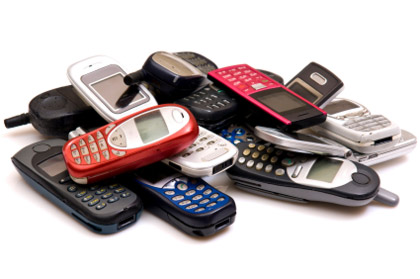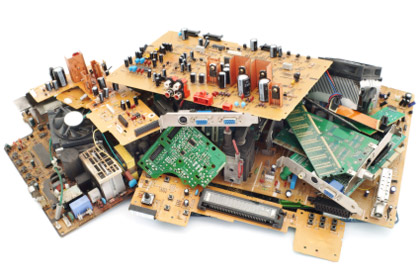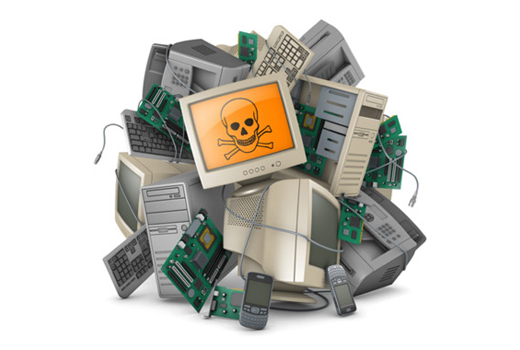Stopping e-Waste Dumping While Creating 42,000 U.S. Jobs
Wow often do Americans have the opportunity to choose a path that promotes sustainability and helps strengthen the economy? So often it seems like people are told they must choose either one or the other. Does the United States want clean streams or coal mining jobs? Does it protect the endangered red-cheeked squirrel or build the solar panel plant? But, when it comes to the question of how the country manages its electronic waste, a solution exists that could both help the environment and create tens of thousands of jobs in the United States. First a little background on the problem. Everyone is buying and disposing of an ever increasing number of electronic gadgets. The average U.S. household owns 24, according to the Consumer Electronics Association. These products contain many toxic chemicals, including lead, mercury, beryllium, arsenic and various brominated flame retardants. Their presence is one reason why e-waste doesn’t belong in the trash. Landfilling or incinerating these products can result in human or environmental exposure to these chemicals. But, trashing these electronics is also a waste of their recyclable resources, which can be recovered by electronics recyclers.
The solution seems pretty easy. Take old TVs, printers, computers and other gadgets to an electronics recycler since e-waste collection sites and events are proliferating in most parts of the country. Unfortunately, this is where the problem gets complex. The company that took that huge, old TV that was hauled down to the Earth Day recycling event may not actually recycle it at all. Instead, the company may simply load it onto a shipping container and send it off to China, India, Ghana or another developing country. Once there, it will undergo some fairly crude processing in what’s called the “informal recycling sector” where workers have no safety protection and are routinely harmed by the toxic chemicals inside.
What Happens when America Exports e-Waste to China?
Here’s a typical scenario: Workers – sometimes children – use whatever tools they can find to open up products. Tube TVs and monitors are often bashed open with a hammer or even a rock, releasing toxic phosphors. Workers are after the metals inside, which they can sell. They heat circuit boards over a wok or open flame to loosen the lead solder and, consequently, breathe in lead fumes. They separate gold from circuit boards using acid, which is then dumped in a river or on land. Plastics are often burned, including the plastic that covers wires, to expose the copper inside. But, flame retardants in these plastics will convert to deadly dioxin when burned. So, workers and people nearby breathe in dioxin, which is incredibly toxic.

© iStockphoto.com/bakalusha
These workers are literally being poisoned, and this has been happening for so long that scientists have been able to study the exposure and impacts. Studies of Guiyu, China, where much of America’s e-waste goes, found that more than 80 percent of children living there have lead poisoning. In addition, workers have extraordinarily high levels of toxic fire retardants and their toxic by-products in their bodies, and the water is unsafe to drink.1 Other studies have found contamination in the soil and groundwater. As a result, water in Guiyu must now be trucked in since the groundwater is too polluted to drink. Similar studies of e-waste workers in Ghana have found high levels of lead, iron and antimony in workers.2
If people know this kind of harm is occurring, surely it must be illegal for U.S. companies to dump e-waste in these countries, right? Unfortunately, most of this export is not illegal, at least not under U.S. law. The United States has only one rule, which puts limits on exporting used CRTs (cathode ray tubes) to developing nations, but it’s routinely ignored. These exports do, however, violate laws of most importing countries, who consider these activities to be criminal trafficking in hazardous waste.
Federal Legislation to Fix the Problem & Create Jobs
But, a good solution is available that would stop America’s contribution to this horrific problem and create tens of thousands of jobs in the United States. Federal legislation, the “Responsible Electronics Recycling Act (RERA),” was introduced in the last Congress and will be reintroduced in this new Congress.3 This legislation would make it illegal to export toxic e-waste, including non-working or untested products and parts, from the United States to developing nations. This is consistent with the majority of nations via treaties that basically say developed nations shouldn’t send their toxic waste to poorer, developing countries. Although the United States has not ratified those treaties, it could adopt the same policy, for e-waste at least, via federal legislation.
The bill would not stop export of tested and fully functional equipment from being exported for reuse. And, it would not stop cleaned commodities from being exported for feedstock to manufacturing. By keeping the disassembly and initial processing work in the United States, the bill would result in higher value exports when commodities are exported for manufacturing. The bill is supported by many electronics manufacturing companies, including Dell, HP, Apple, Samsung and Best Buy, who already have policies consistent with RERA.
Study Predicts 42,000 Additional Jobs
A study4 released in January 2013 by the Coalition for American Electronics Recycling (CAER) estimates passage of the Responsible Electronics Recycling Act would result in as many as 42,000 new jobs in the United States. One-half would be recycling industry jobs and the remainder would be indirect jobs with businesses that service and supply recyclers. The new jobs would drive about $1 billion in new payroll per year. As more e-waste is diverted away from landfills and into recycling, those numbers will only increase.

© iStockphoto.com/ermingut
While the predominant trend in the United States is to export e-waste to developing countries, many U.S. recyclers are successful without relying on this business model. Many have been certified to a high standard for electronics recyclers, called the “e-Stewards Standard for Responsible Recycling and Reuse of Electronic Equipment,” known as “e-Stewards.”5 These companies have brick and mortar facilities in the United States and have already made a significant investment in equipment and facilities. But, none operate at capacity because they are consistently undercut by exporters, who are often brokers with very little overhead, often just a truck, a loading dock and a handful of employees. Exporters can underbid responsible recyclers who are also paying to protect their workers from dangers posed by the toxic materials they handle.
Passage of RERA would mean Americans who recycle wouldn’t have to wonder if the company collecting e-waste at their Earth Day recycling event was an exporter. That practice, which undercuts the basic ideology of all who recycle, would become illegal.
What Can Americans Do in the Meantime?
Until such time as RERA is passed and becomes law, consumers, businesses and federal agencies can still do things to make sure their used electronics don’t end up being dumped in developing countries:
- Use an e-Steward recycler. Make sure used electronics are managed by a recycler certified to the e-Stewards standard. A competing but much weaker standard exists, called “R2,” but it doesn’t prohibit exporting e-waste to developing nations. R2 is also weak in many other areas.
- Don’t auction off used equipment. It’s not uncommon for federal or state agencies or some businesses to consign lots of used electronics to an auctioneer. But auctions simply go to the highest bidder, which means auctioned products may be managed irresponsibly.
- Don’t use prison recycling. Most federal government e-waste goes to federal prison recycling operations run by Federal Prison Industries, also known as “UNICOR.” UNICOR is a business entity that is a wholly-owned subsidiary of the Department of Justice. A 2010 review of UNICOR by the Inspector General found the following: “numerous violations of health, safety and environmental laws, regulations and BOP (Federal Bureau of Prisons) policies;” inmates and prison staff were exposed to lead and cadmium; “numerous instances of staff misconduct and performance failures,” as well as potential criminal conduct by UNICOR staff.6
Two lawsuits were filed in May 2012 on behalf of Marianna, Fla., federal prison staff and their families over diseases and ailments they believe are related to exposure to toxics at these e-waste recycling activities. Family members say they were exposed by dust and contamination that traveled home on workers’ clothes and shoes.
This author’s coalition, then called the “Computer TakeBack Campaign,” contributed to a 2006 report on problems at UNICOR prison recycling called “Toxic Sweatshops.”7 The report documents many of these problems with UNICOR recycling, including how they are undercutting U.S. commercial recyclers. UNICOR pays inmate workers from $.23 to $1.15 per hour, but they don’t have to pay for benefits, worker’s compensation or payroll taxes.
Federal Agencies Could Lead by Example
According to the General Accounting Office, the U.S. government is the world’s largest purchaser of electronic products and services – $75 billion in 2009 alone – and, therefore, the largest generator of e-waste.8 What federal agencies do with their old products can have a large impact in this sector as well as be a model for what other government agencies and private companies should be doing.
While the federal agencies’ new e-waste disposition policy, as announced by General Services Administration (GSA) in March 2012,9 claims to lead by example, it actually falls short of real leadership. A GSA bulletin10 instructs federal agencies not to landfill or incinerate e-waste and to take steps to encourage reuse where possible. While these are all good things, the policy is weak on the export issue. It only requires compliance with federal, state and local laws, which is almost meaningless since e-waste is largely unregulated. It encourages but doesn’t require use of recyclers certified to either the weak R2 standard or the e-Stewards standard.
The federal government could show real leadership in how it manages used electronics, purchased with taxpayer money, by issuing a clear policy stating that federal e-waste (untested or non-working products or parts containing toxic materials) may not be exported to developing nations or handled by prison labor. This is the policy of many Fortune 500 corporations in the United States, including many electronics manufacturers like Dell, HP and Apple.
If federal agency e-waste were redirected to responsible commercial recyclers, and away from UNICOR or exporters, the U.S. government would be making a meaningful investment in the American economy and the nation’s environmental sustainability.





























